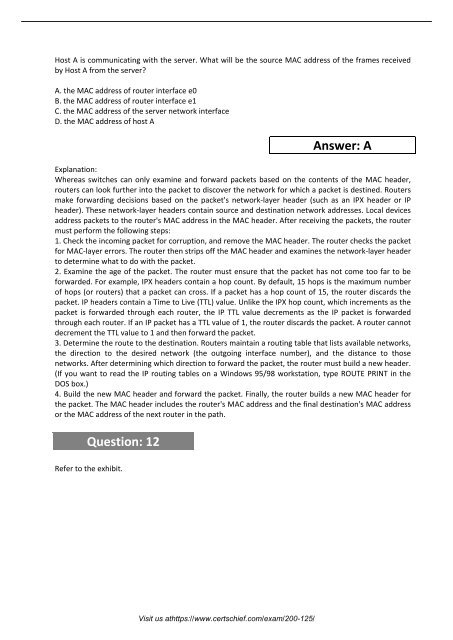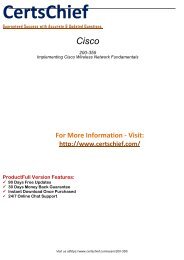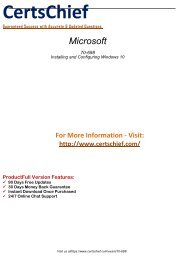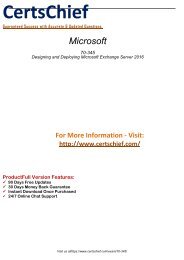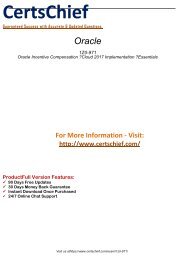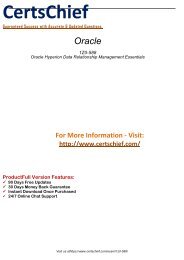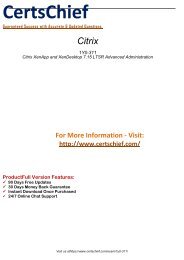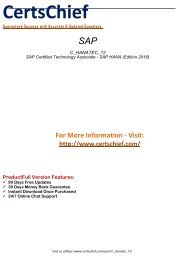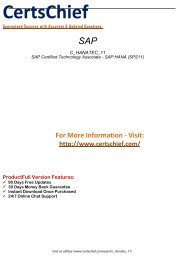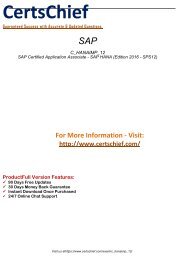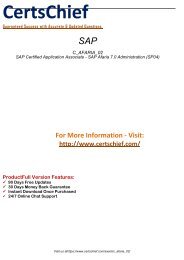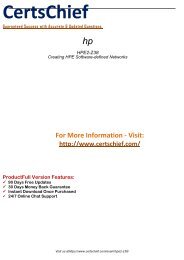200-125 Practice Test Software
Study kits and preparation materials provided by us for 200-125 Test are authorized by the professionals and industry experts. You can easily pass your certification test with our brain dumps and PDF sample questions. For more info please visit here: https://www.certschief.com/exam/200-125/
Study kits and preparation materials provided by us for 200-125 Test are authorized by the professionals and industry experts. You can easily pass your certification test with our brain dumps and PDF sample questions. For more info please visit here: https://www.certschief.com/exam/200-125/
Create successful ePaper yourself
Turn your PDF publications into a flip-book with our unique Google optimized e-Paper software.
Host A is communicating with the server. What will be the source MAC address of the frames received<br />
by Host A from the server?<br />
A. the MAC address of router interface e0<br />
B. the MAC address of router interface e1<br />
C. the MAC address of the server network interface<br />
D. the MAC address of host A<br />
Answer: A<br />
Explanation:<br />
Whereas switches can only examine and forward packets based on the contents of the MAC header,<br />
routers can look further into the packet to discover the network for which a packet is destined. Routers<br />
make forwarding decisions based on the packet's network-layer header (such as an IPX header or IP<br />
header). These network-layer headers contain source and destination network addresses. Local devices<br />
address packets to the router's MAC address in the MAC header. After receiving the packets, the router<br />
must perform the following steps:<br />
1. Check the incoming packet for corruption, and remove the MAC header. The router checks the packet<br />
for MAC-layer errors. The router then strips off the MAC header and examines the network-layer header<br />
to determine what to do with the packet.<br />
2. Examine the age of the packet. The router must ensure that the packet has not come too far to be<br />
forwarded. For example, IPX headers contain a hop count. By default, 15 hops is the maximum number<br />
of hops (or routers) that a packet can cross. If a packet has a hop count of 15, the router discards the<br />
packet. IP headers contain a Time to Live (TTL) value. Unlike the IPX hop count, which increments as the<br />
packet is forwarded through each router, the IP TTL value decrements as the IP packet is forwarded<br />
through each router. If an IP packet has a TTL value of 1, the router discards the packet. A router cannot<br />
decrement the TTL value to 1 and then forward the packet.<br />
3. Determine the route to the destination. Routers maintain a routing table that lists available networks,<br />
the direction to the desired network (the outgoing interface number), and the distance to those<br />
networks. After determining which direction to forward the packet, the router must build a new header.<br />
(If you want to read the IP routing tables on a Windows 95/98 workstation, type ROUTE PRINT in the<br />
DOS box.)<br />
4. Build the new MAC header and forward the packet. Finally, the router builds a new MAC header for<br />
the packet. The MAC header includes the router's MAC address and the final destination's MAC address<br />
or the MAC address of the next router in the path.<br />
Question: 12<br />
Refer to the exhibit.<br />
Visit us athttps://www.certschief.com/exam/<strong>200</strong>-<strong>125</strong>/


